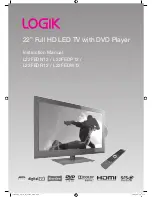
MG5.1E
6. SMALL SIGNAL PANEL
35
6.3 Control and TXT
Control part
Remote Control
In MG5.1E a new remote control is introduced which uses RC6,
because new commands are used like cursor control in 8
directions. There are two mode buttons on the side of the
remote control: One for VCR and the other for DVD/SAT (digital
source).
OTC
The SAA5800 (IC7003) is called the OTC (OSD, TXT and
CONTROL). In this IC the microprocessor and the TXT-
decoder are integrated. The SAA5800 is also called the
OTC2.5 because also TXT-level 2.5 is supported.
The OTC has also :
•
RGB outputs for blending. The contrast (for blending) is
software controlled.
•
OTC 2.5 has various I/O ports for I2C, RC5, LED, ....
The software for MG can be 2 MB (Megabyte). For sets with
nexTView (also called EPG) a 512 KB flash-RAM IC7013 is
used to store the Electronic Program Guide. For TXT-data 440
pages can be stored in a RAM IC7001. This is a DRAM of 4 Mbit
and this IC is also used to store data of a working set. The Non
Volatile Memory IC7008 is a 32 kbit version M24C32W6. All ICs
in this part are supplied with 3V3. For this voltage a 3V3
stabiliser is used (IC7009). At start-up the POR is generated
with TS7006/7007. During a reset all I/O pins are high. When a
POR is generated the TV-set is in Standby mode. Via pins 105
and 106 the 8V6 and the 5V2 are sensed. If one of them is not
present, the FFS-supply is switched off. The OTC will generate
an error code to indicate what was wrong.
The horizontal and vertical flyback pulses are also fed to the
OTC for stable OSD and TXT. To create good stable pulses the
HFB(H) and VFB(V) are inverted and fed to the OTC. The RGB-
outputs (77/78/79) together with fading (pin 80) is fed to the
HOP.
The fading pin has in fact a double function:
•
Make transparent menu
•
Fast-blanking for TXT
In MG5.1E there are three I2C-busses used:
•
Slow I2C bus for tuner, fbx, video- and audio-selection
•
Fast I2C bus for the HIP, HOP, MSP3410 and the TOPIC
•
NVM- I2C bus for the Non Volatile Memory to prevent data
corruption (=I2C3)
The OTC has also a connection with mains switch/led panel:
•
Driving the “ON” and “Standby”-leds . The green led gives a
quick indication that the 8V6 is present.<----- Service tip
•
MG5.1E has an IR-send led connected to pin 90 for
communication with DST or ComPair.
•
The remote control signal comes in on pin 100. This can be
RC5 or RC6 commands.
TXT
The TXT-decoder in the OTC gets two video signals: Direct to
pin 5 and via the peaking filter (for Scandinavian countries) to
pin 7. The input is selected via country selection in the
installation menu. The RGB-outputs are available on pins 77/
78/79. Fast blanking is realised via pen 80, but TS7017 and
TS7018 are added to create a nice fast blanking signal that is
needed in the TXT-mixed mode. These transistors are driven
by an extra fast-blanking signal from pin 81. In future sets this
circuitry will be deleted. In the previous chassis there was
separate memory to store the TXT information. In MG the RAM
(IC7001) of the microprocessor is also used for the TXT-
decoder.
NexTView
NexTView allows the user to display a program guide on the TV
screen which contains extensive information for each program.
This information can be displayed in a number of different
summaries:
–
DAY: The daily summary shows, from the current moment,
the program schedule for several stations for a short time
ahead.
–
CHANNEL: The channel summary shows the program
schedule for one station.
–
THEME: The theme summary shows, for each theme, the
program schedule of the various stations. These themes
consist of sport, film, culture, etc. and is determined from
the station side.
NexTView does not have to restrict itself to information about
the station which is being viewed, but also offers information
about other stations. In the various summaries 3 different
commands can be given for the various program overviews.
These commands appear as follows:
–
WATCH: The set immediately switches over to the station
concerned.
–
REMINDER: The start time and date and the station of the
program concerned is stored in the TV reminder list. The TV
will give an OSD-message with the program information, or
switch on the set at the correct moment (provided the set is
in Standby) and tune to the station concerned.
–
RECORD: The timer of the video recorder with ‘Easylink
Plus’ is programmed with the data of the program
concerned. There has to be a video recorder (with Easylink
Plus) connected to SCART2 otherwise the ‘RECORD’
function will not be highlighted. The connection is via pin 10
from SCART. This means that it has to be a full SCART or
at least pin 10 has to be wired.
In order to be able to realise nexTView, two teletext type data
flows, Datastream 1 and 2, are transmitted with various sub-
code pages of information. This data flow can transport limited
information (max. 40 pages). Datastream 1 is quick repeating
with a repetition time of approximately 20 to 30 seconds.
However, Datastream 2 has a much longer repetition time of
approximately half an hour and has a large transport capacity.
–
Datastream 1 contains information of the station which is
being viewed.
–
Datastream 2 contains up to one week of advance
information from various stations which are covered by the
provider.
















































